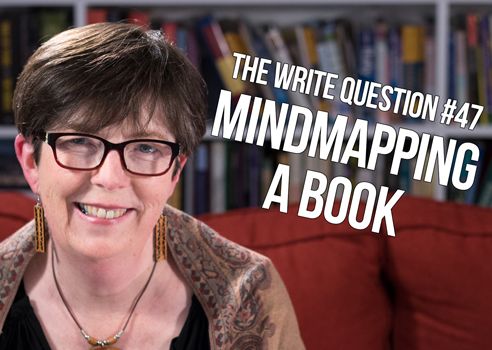Viewing time: 4 min. 4 sec.
The Write Question is a weekly video podcast about writing that I started in 2017 and that ran, more or less weekly, until April 2022. This is a republication of issue #47, about how mindmapping books helps writers. The post first ran on Feb. 23/18.
Transcript:
Welcome to The Write Question, I’m Daphne Gray-Grant. Today we’re talking about mindmapping books.
I’m answering a question from Brandon Ford in Olympia, Washington. Here’s what he asked:
[phone recording] Hi Daphne, Like you, I learned to write in the newspaper business. I feel comfortable writing article-length pieces and I imagined I’d never want to write a book. Well, now I have a book-length story to tell and I’m having trouble getting started. Also, like you, I hate outlines and never use them. Now I’m tempted. Could mindmapping save me? How do you mindmap a big project like a book?
Thanks for the question, Brandon. I talk about mindmapping a lot and I appreciate the way you’re giving me the chance to speak about one very specific — and useful way — to employ the technique.
Most mindmaps are what I call “inspirational.” They are not intended to be outlines that capture everything you want to say. Nor are they intended to identify the ORDER in which you want to address points Instead, their purpose is to INSPIRE you to write.
But a mindmap for an entire book — or one for a thesis — is different. It needs to be much bigger than a conventional mindmap. And it should take you much longer to create.
A regular mindmap can be contained on an 8-1/2 x 11 or 11 x 17 piece of paper. (Just remember to turn that paper sideways, of course!)
A book or thesis mindmap — let’s call it a planning mindmap— needs to be much larger. To prepare one of those you need paper on a ROLL — either butcher’s paper or unprinted upon newsprint. You can often get this paper from a craft store or a newspaper press room if there happens to be one remaining in your city. If worst comes to worst, you can also use paper supplied by moving companies, taped together, like this.
Whatever paper you use, spread it out on the largest flat surface you can find — a boardroom table, a library table or a dining-room table with all the leaves in it. I would suggest using a bigger table than this one. This is a planning mind-map based on my book, 8½ Steps to Writing Faster, Better.
Now, let’s talk about timing. A traditional mindmap should take you no more than 3 to 5 minutes. But a planning mindmap could conceivably take several hours and maybe several days, with you taking numerous breaks and going back and forth to it.
The objective with a planning mindmap is to identify all the chapters that are going to be part of your book and all the major lines of argument as well. Thus, a planning mindmap will be more factual than inspirational.
In fact, a planning mindmap is also organizational. Once you have it finished, you should then take a different coloured pen and mark the entries that represent the chapters you want to be part of your book or thesis. I like to use an asterisk to do this.
Then, type up a list of those chapters and put it in a word document. Voila! Your planning mindmap has done its job for you.
Just one more thing. Don’t imagine that your mindmaping for your book is complete. Even once I’ve done my planning mindmap, I still do at least one inspirational mindmap every day, before I write.
Finally, while we’re on the subject of writing books, let me wrap up with a quote about book writing from T.S. Elliot: “If you start with a bang, you won’t end with a whimper.”
Thanks for your question, Brandon. I hope the technique of mindmapping books helps you start your own book with a bang!
Links:
Are you making any of these mindmapping mistakes? (video)


